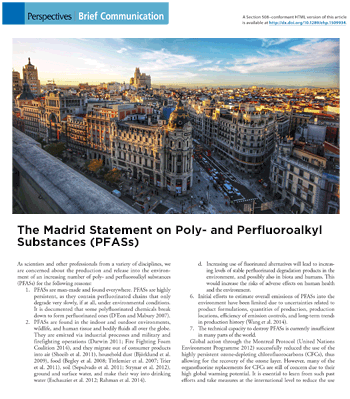PFAS
These “forever chemicals” don’t break down in the environment and can harm our health
What are PFAS?
Per- and polyfluoroalkyl substances (PFAS) are chemicals that contain bonds between carbon and multiple fluorine atoms. These strong carbon-fluorine bonds give PFAS useful chemical properties for making products oil-, stain-, and water-repellent, or non-stick. These same carbon-fluorine bonds also make PFAS extremely resistant to breakdown.
PFOA and PFOS are the best known of the thousands of related PFAS chemicals. Exposure to PFOA, PFOS, and related PFAS is associated with health harm, including immune suppression, high cholesterol, and certain cancers. Learn what you can do.
Learn more about products that may contain PFAS.
How are we exposed?
We are exposed to PFAS through contaminated food, drinking water, air, and dust, as well as PFAS-containing products. Where drinking water is contaminated, it can be the largest source of exposure. In other areas, exposures from diet -- both from food packaging and the food chain -- may predominate. In indoor environments, PFAS migrate out of products and into dust and air.
PFAS are found in the bodies of 99% of Americans. Learn more on our exposure page.
What are the concerns?
PFAS are often:
PERSISTENT: Do not break down into safer substances in the environment. We can continue to be exposed from food, drinking water, and products years after a chemical is banned or phased out.
MOBILE: Travel far and are distributed around the world. PFAS are present in the deep oceans, mountain lakes, and polar regions far from where they were produced and used.
BIOACCUMULATIVE: Build up in people and animals. Certain PFAS bioaccumulate--they remain in the bodies of humans and animals for years. Bioaccumulative PFAS are most concentrated at the top of the food chain, in marine mammals, birds of prey, and humans.
TOXIC: Harmful to humans and ecosystems. The best-studied PFAS, PFOA and PFOS, are linked to liver damage, high cholesterol, obesity, diabetes, cancer, thyroid disease, asthma, immune system dysfunction, reduced fertility, low birth weight, and effects on children’s cognitive and neurobehavioral development.
Ongoing research is finding similar health harm in other PFAS as they are studied.
Safer replacements?
Production of long-chain PFAS has been phased out in North America, Europe, and Japan due to their potential for health harm. They have been replaced by short-chain PFAS and other related chemicals that are equally persistent and may pose similar risks. A notable example is GenX: the manufacturer of this chemical claimed that it was a safe replacement for PFOA, but researchers have since shown that it has similar toxicity and have found it in the drinking water of hundreds of thousands of people. For more on this problem, see our fact sheet.
All PFAS are persistent or have persistent breakdown products. The entire class of PFAS should be avoided when possible.
When should PFAS be used?
Because of their extreme persistence and their associated risks, PFAS should only be used when they are essential. This includes uses for which there are currently no viable non-fluorinated alternatives, such as certain medical devices and occupational protective clothing. Reducing non-essential uses of PFAS is critical.
What are the sources of PFAS pollution?
The manufacture, use, and disposal of PFAS has led to pervasive contamination. Point sources include:
Fluorochemical production
- Chemical factories where PFAS are made have been responsible for large volumes of emissions. Teflon and PFAS factories in Parkersburg, WV, and Fayetteville, NC, are two notable examples that have caused severe contamination of their local environments.
Other manufacturing
- Facilities that use PFAS to make other products are more numerous than fluorochemical production plants. Some of these sites have also caused serious contamination. Examples include plastic and textile plants, leather tanneries, paper mills, and metal plating shops.
Firefighting foam
- Most of the known PFAS-contaminated sites in the U.S. are related to the use of firefighting foam. These sites include military sites, airports, fire-training areas, and locations of past fires. Users of firefighting foams should adopt PFAS-free alternatives whenever possible.
Wastewater treatment
- PFAS from products used in homes and businesses are flushed down the drain to wastewater treatment plants. These facilities typically cannot remove PFAS, so the chemicals pass through into treated water and biosolids. Land application of biosolids can contaminate agricultural soils, which can lead to contamination of food crops and livestock.
Landfills
- PFAS enter landfills in discarded products such as apparel, carpet, and food packaging. PFAS can migrate out of products and into landfill leachate. Typical leachate treatment systems do not remove PFAS, so landfill leachate can be a source of contamination to adjacent water bodies.
What is being done?
The Green Science Policy Institute works with scientists, lawmakers, and advocates to limit the use of PFAS in products and decrease our exposure to these “forever chemicals”. In 2015, we published the Madrid Statement, encouraging society to limit the production and use of the entire class of PFAS. This consensus statement was signed by over 200 scientists from around the world and catalyzed increasing awareness of PFAS.
Manufacturers and large purchasers are reducing PFAS in the products they make and buy. Policymakers are increasingly focused on controlling PFAS exposures. Even so, researchers are continuing to identify previously unknown types of PFAS in the environment. Find out more here.
What can you do?
Watch our short introductory video on PFAS. Learn about safer products on our consumer resources and PFAS-free products pages. Discover how to limit toxic chemicals in your life on our exposure page.
Videos
PFAS: Four-minute introduction
PFAS as a Class: Press conference with Sen. Blumenthal, Rep. Kildee, & scientists
PFAS as a Class: Scientists make the case
Therese Lilliebladh: How IKEA is phasing out PFAS


